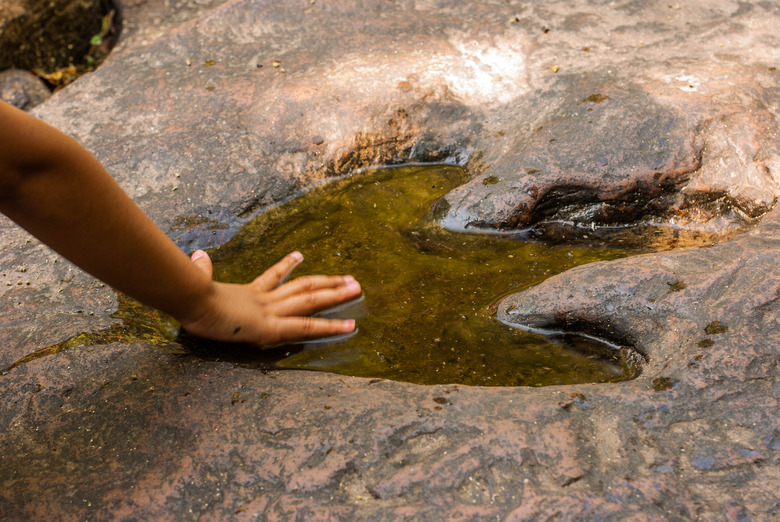What Are Trace Fossils?
Fossils provide remarkable glimpses into the history of life on Earth. While the giant dinosaur fossils like T. rex and Apatosaurus may dominate the public eye, smaller fossils such as cyanobacteria and trilobites offer even more fascinating insights into the ancient world. Fossils remain rare, however, and some of the most tantalizing hints at the habits of past life come from trace fossils.
TL;DR (Too Long; Didn't Read)
Trace fossils are indicators of the activities and behaviors of past life. Examples of trace fossils are tracks and trails, borings, burrows, gastroliths and coprolites.
Trace Fossil Definition
Trace Fossil Definition
Trace fossils give glimpses into how animals behaved and what their activities were like, including what they ate. Another name for trace fossils is ichnofossils, from the Greek "ikhnos," which means track or trace.
Types of Trace Fossils
Types of Trace Fossils
Most trace fossils can be placed into three general categories: tracks and trails, burrows and borings, and gastroliths and coprolites. Each of these types of trace fossils helps decipher the activities of past life.
**Tracks and Trails:** A simple walk along a beach shows a patient observer some of the life in the area. Tracks in the sand may show the three-toes-forward tracks marking a bird's presence. A trail of alternating scurrying footprints separated by a line indicates a lizard dragging its tail as it runs, and small, parallel, rounded pinpricks suggest a skittering insect. Most of the time these marks will be washed or blown away within a very short time. But, sometimes these marks are buried and preserved in rock and eventually solidify. Mud, silt and fine sand tend to hold the shapes of the visitors' footprints and trails long enough to be buried and potentially discovered.
Tracks and trails are particularly useful in understanding how animals moved. The distance between footsteps suggests the length of an animal's stride. Combining the length of the stride with any gouging that indicates running give hints at the size of the organism.
**Burrows and Borings:** Many animals burrow into the substrate. Present-day earthworms, clams and ant lions are just three modern examples. These activities leave recognizable patterns in the sediments. When these same patterns appear in ancient rocks, they indicate similar behaviors. In many cases the remains of the actual animal have decomposed or have been consumed by contemporaneous organisms, but the burrow traces remain.
Borings into wood or other materials like shells or bone indicate insect, worm or other parasitic activity. In the fossil record, animals with soft bodies or with fragile exo- or endoskeletons rarely leave fossils. However, when paleontologists (scientists who study fossils) see borings in fossilized wood, they know that insects most likely also lived in the same time and place as the wood, even if no insect fossils have been found.
**Gastroliths and Coprolites:** Gastroliths and coprolites help interpret the eating habits of ancient creatures. Gastroliths translates to "stomach stones" and are found in the stomachs or gizzards of birds, many reptiles and some mammals. In birds, the stones help grind up the birds' food. In crocodiles, the stones may help grind up or break down food. In seals and whales, the stones may simply be a side effect of their eating habits, swallowed accidently. Similar interpretations have been applied when gastroliths are found within the rib cages of fossilized dinosaurs.
Coprolites are fossilized feces. In other words, fossilized poop. But not to worry, the smell disappears in the fossilization process. In any case, coprolites contain the undigested remnants of an animal's meal. Examining coprolites reveals what an animal ate and also clues to the digestive rate and bacteria in its gut. For example, bones found in a T. rex coprolite showed not only what the carnivore had recently eaten, but also that the bones were marked but not destroyed by stomach acids, indicating a rapid trip through the T. rex's digestive system.
**Other Trace Fossils:** Rarely seen but equally fascinating clues to past life include imprints of skin, fur and feathers.
Trace Fossils and Environment
Trace Fossils and Environment
Trace fossils preserve the moment of activity of an animal and therefore indicate the habitat of the animal. For example, trace fossils of burrows in mudstone show that the animal lived in a muddy environment. Mud accumulates in water that is very still, such as ponds, lakes, lagoons or ocean floor. So, the burrowing animal was aquatic and preferred still water.
Trace Fossil Challenges
Trace Fossil Challenges
Trace fossils often appear separate from the organism that made them. Knowing exactly which organism and its activity caused the trace fossil is therefore difficult and sometimes impossible. In addition, there are natural events that create similar patterns but are not made by a living creature. These realities make the study of trace fossils particularly challenging.
Trace Fossil Classification Systems
Trace Fossil Classification Systems
Two different classification systems for trace fossils have been developed. One trace fossil identification chart, the Ethological System, uses behavior indicators. The other trace fossil identification chart, the Toponomic System, looks at the relationship of the trace fossil to the sediments it was found in.
Cite This Article
MLA
Blaettler, Karen G. "What Are Trace Fossils?" sciencing.com, https://www.sciencing.com/trace-fossils-8214083/. 13 August 2018.
APA
Blaettler, Karen G. (2018, August 13). What Are Trace Fossils?. sciencing.com. Retrieved from https://www.sciencing.com/trace-fossils-8214083/
Chicago
Blaettler, Karen G. What Are Trace Fossils? last modified March 24, 2022. https://www.sciencing.com/trace-fossils-8214083/
